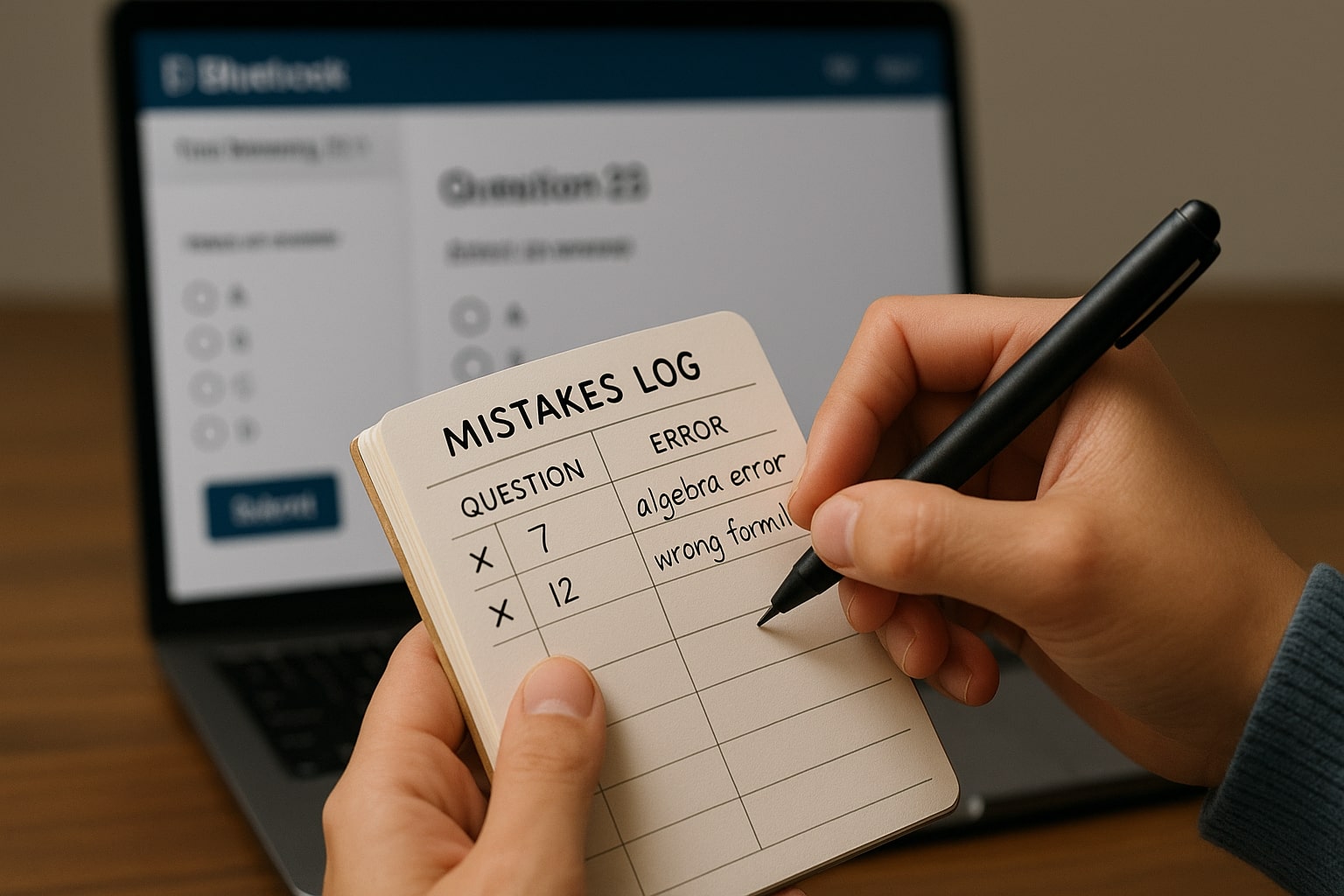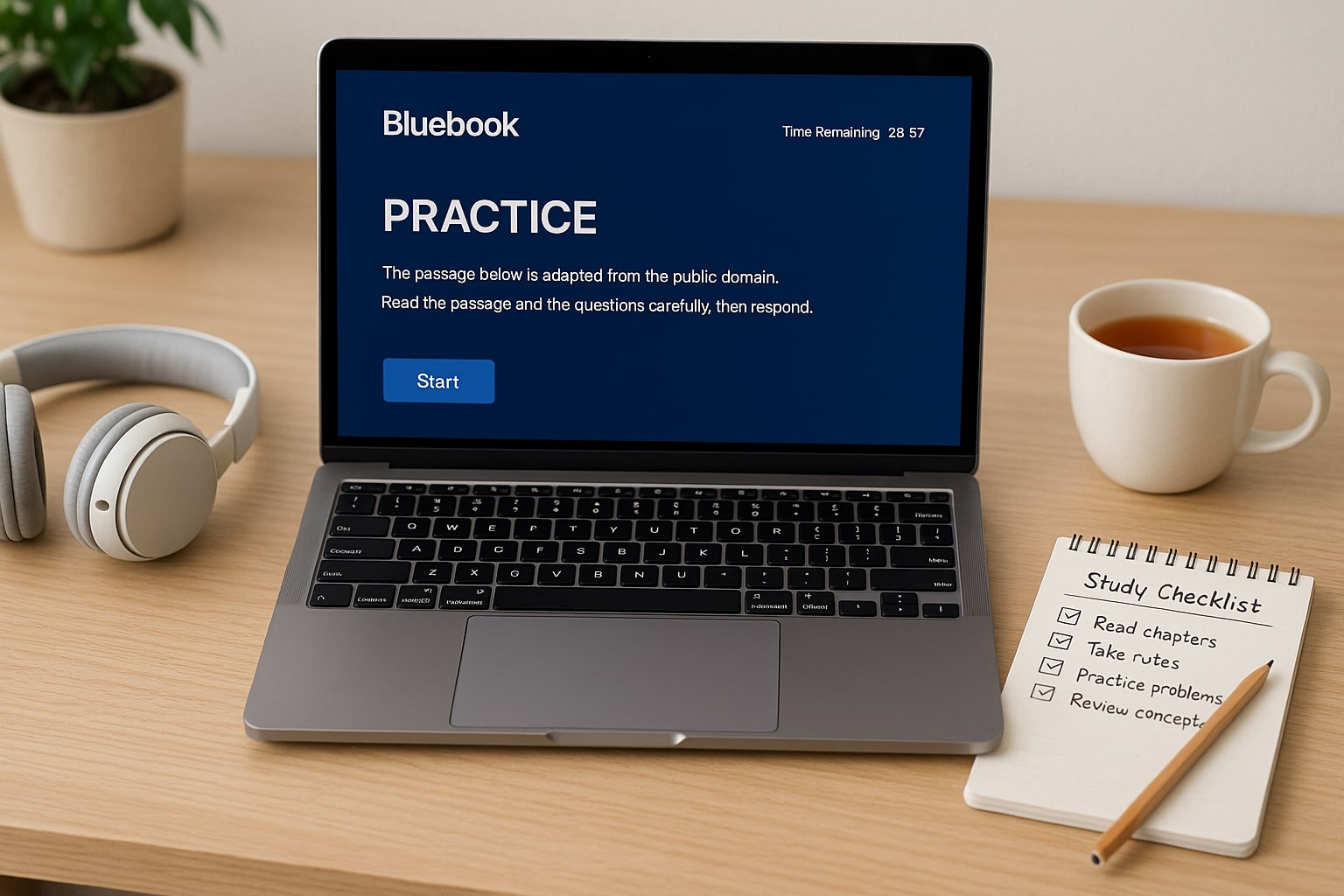Why Bluebook practice should be the center of your Digital SAT prep
If you want a realistic, high-value way to prepare for the Digital SAT, Bluebook should be where you spend a good chunk of your practice time. That’s because Bluebook is the actual testing app you’ll use on test day: it replicates the interface, tools, timing, and — most importantly — the adaptive format of the exam. Practicing in the same environment removes surprises, builds comfort with the exam layout, and gives you accurate practice scores and feedback you can use to shape your study plan.
Not just practice — rehearsal
Think of Bluebook practice as rehearsal, not just problem-solving. Actors rehearse their lines in the theater where they’ll perform; you should practice the SAT in the software where you’ll take it. When you practice in Bluebook, you’re working on content AND context: how to flag questions, use the built-in tools, navigate adaptive sections, and manage the rhythm of the digital test.
Getting started: setup, account, and the test preview
Before you take your first full practice test, make these three quick checks:
- Install Bluebook on the same device type you plan to use for the exam (Windows/Mac/iPad/Chromebook). Familiarity with your device reduces friction on test day.
- Create or sign into your College Board account in Bluebook so practice results can sync to My Practice for review.
- Try the Test Preview. It’s short, untimed, and helps you learn the tools without score pressure. Use it to test text size, answer-entry methods, and accessibility features if needed.

Designing a smart Bluebook practice schedule
Practice is valuable, but only if it’s deliberate. A scattered “take a test every few days” approach won’t help you much. Instead, aim for a rhythm that balances full-length practice tests with targeted skill work and review.
A sample 8-week rhythm
- Weeks 1–2: Diagnostic + baseline. Take one full-length Bluebook practice test under realistic conditions to set a baseline.
- Weeks 3–6: Cycle of targeted practice. Each week: one full Bluebook test + 2–3 shorter practice sessions (Student Question Bank, Official Khan Academy, timed section practice).
- Weeks 7–8: Taper and polish. One or two full Bluebook tests with final targeted drills on weak areas, plus light review and strategy tuning the day before your real test.
This schedule mixes the “big picture” of full tests with the surgical precision of skill practice.
How often should you take full-length Bluebook tests?
For most students, one full Bluebook practice test every 7–10 days is a healthy pace while in active prep. Too many full tests too quickly can burn time without giving you space to review and improve. The value in a practice test comes from the review — not the test itself.
Before the practice run: make the conditions real
When you take a Bluebook test, simulate test day as closely as possible so the practice is meaningful. Key elements to replicate:
- Time of day: If your test is in the morning, practice in the morning.
- Environment: Use a quiet space with minimal interruptions.
- Breaks and rules: Follow the same break structure and avoid phone use during the test.
- Calculator and tools: Use the same calculator settings or in-app tools you’ll rely on during the exam.
During the test: strategy for adaptive sections
The Digital SAT adapts across sections. Your performance in the first module influences the difficulty of later modules. That changes some common test-taking habits — it rewards consistent accuracy more than blind speed early on, and it rewards smart time allocation within each module.
Practical approach to adaptive sections
- Start steady: In the first module, prioritize accuracy over frantic speed. A few safe, confident answers help place you into a test path where you can gain more points.
- Pace by module: Each module is a mini-test. Set small time checkpoints (for example, after 10–12 questions) to keep momentum without rushing.
- Flag strategically: If a question is taking too long, flag it and move on. You can return if time allows — but don’t let one hard question derail the module.
After the test: review like a pro
How you review Bluebook practice tests determines how much you’ll improve. Treat the review as the most important part of the session.
Structured review checklist
- Score and section-level performance: Note which modules showed strength and which were weak.
- Question-type analysis: Group missed questions by type (e.g., data interpretation, evidence-based, grammar rule, quadratic equation). Look for patterns.
- Timing analysis: Identify questions where you ran out of time or hesitated. Were these solvable with a pace adjustment or a content fix?
- Technique vs. knowledge: Decide whether an error was conceptual (you didn’t know the math) or strategic (you ran out of time, misread, or chose the close-but-wrong answer).
- Create practice tasks: From your review, extract 3–5 actionable drills for the next week (e.g., 15 data interpretation problems, 25 sentence-correction items, or 10 timed algebra practice problems).
Use My Practice and the Student Question Bank
After a Bluebook practice test, your results can feed into My Practice and the Student Question Bank. Use those tailored question sets to target your most common errors. Don’t just grind questions — pick items that hit the exact skills flagged in your review.
How to interpret Bluebook feedback and scores
Bluebook gives official practice scores that are useful benchmarks, but remember: practice scores are indicators, not guarantees. What matters is how your scores move over time and whether your error patterns are shrinking.
| What to look at | Why it matters | Action step |
|---|---|---|
| Total scaled score trend | Shows overall progress — are you improving over multiple tests? | Track scores across 3–4 tests and compare with study intensity. |
| Section-by-section accuracy | Reveals stronger/ weaker content areas (Math vs. Reading/Writing). | Shift weekly study blocks to emphasize weak sections. |
| Question-type clusters | Identifies recurring problem types (e.g., inference questions). | Create focused drills in the Student Question Bank or Khan Academy. |
| Timing breakdown | Shows whether time management or content knowledge is the issue. | Practice timed modules and use pacing checkpoints. |
Active review techniques that stick
Passive review (just reading answer explanations) won’t move the needle as fast as active, varied practice. Here are high-ROI review tactics:
- Explain it aloud: For every missed question, explain why the correct answer works and why the wrong answers fail — out loud, as if teaching someone else.
- Create a mini-mistakes log: A running list of the 10 most common errors you make, updated after each Bluebook test. Review the log weekly.
- Re-do missed questions under time pressure: Don’t just read the explanation — re-attempt the problem on paper or in the app with a strict timer.
- Mix old and new: Build study blocks that combine fresh practice with deliberate re-practice of older mistakes so knowledge becomes durable.
Tactics for the three Digital SAT domains
Reading and Writing
On the Digital SAT, reading questions often hinge on precise interpretation and evidence. When you miss a reading question in Bluebook, isolate whether the problem was vocabulary-in-context, main idea, inference, or evidence-linking. For writing, focus on logic, concision, and sentence/paragraph structure.
Math (Calculator and No-Calculator modules)
Bluebook’s math practice will reveal whether your errors come from weak algebra, careless arithmetic, or inefficient methods. Build drills around the most frequent algebraic structures you miss: linear equations, systems, quadratics, and data analysis. Practice both mental arithmetic strategies and clean, stepwise written solutions for the digital interface.
Tools and accessibility features
Bluebook includes tools like highlighting, flagging, and built-in rubrics. If you use accommodations, practice them in Bluebook to make sure your configurations are comfortable. The familiarity reduces stress on test day and helps you use the tools fluidly during tight moments.
Time management hacks inside Bluebook
Good time management in Bluebook is about module-level pacing and smart skipping. Try a simple rule-of-thumb: if a question costs more than twice the average time per question in that module, flag and move on. Use periodic time checks at meaningful anchors (e.g., after every 8–12 questions) so you don’t drift into panic at the end of a module.
When to change your study plan
Bluebook will tell you when a plan needs adjustment faster than any feeling of confidence. Consider changing plans when:
- Your practice scores plateau for three or more full-length tests despite steady study hours.
- Your error log shows the same mistake types recurring week after week.
- You’ve moved your test date and need to compress or expand your schedule.
If you find yourself stuck, personalized help can make a big difference. Sparkl’s personalized tutoring is built for situations like this: one-on-one guidance, tailored study plans, expert tutors who interpret your Bluebook data, and AI-driven insights to target the exact skills that are holding your score back. Consider a short tutoring block to break a plateau or to accelerate toward a score goal.
Practical examples: turning a Bluebook score into action
Example 1: You score 620 in Math and 700 in Reading/Writing. Breakdown shows most errors are in algebraic manipulation and data interpretation. Action: three weekly focused math drills (45 minutes each) on algebra and two data-interpretation sets from the Student Question Bank; review a full Bluebook math module every 10 days.
Example 2: You score 660 Reading/Writing but miss many evidence-based questions. Action: practice targeted passage work in Bluebook’s Student Question Bank and re-do missed passage questions explaining evidence links aloud; set up two 30-minute daily reading drills on experiment or economics passages.
Common mistakes students make with Bluebook practice
- Skipping review: They take lots of practice tests but don’t spend the time to dissect mistakes.
- Over-testing: Taking too many full tests without focused skill work in between.
- Unrealistic conditions: Practicing with distractions or different timing, which makes scores unreliable.
- Ignoring tools: Not learning how to flag, highlight, or use the on-screen tools in Bluebook.
Final 2-week checklist before test day
- Take 1–2 Bluebook full-length practice tests under test-day conditions, review thoroughly.
- Tighten your sleeping and nutrition schedule to what you’ll have on test day.
- Review the mini-mistakes log — only the most frequent 10 mistakes, not everything.
- Practice the test preview once more so your device and settings feel natural.
- Plan logistics (device charged, login credentials, permitted materials) so there are no surprises.
Mini final tip
On the day before your test, avoid any heavy new study. Rest, do light review of your fastest wins (formulas, grammar rules, and small pacing reminders), and trust the work you’ve put in. Confidence and calmness are practice outcomes too.
Closing thoughts: practice with intention
Bluebook is a powerful tool when used with intention. Think of each practice test as a diagnostic instrument that tells you where to focus your limited study time. Balance full-length practice with concentrated drills, use active review techniques, and let official Bluebook feedback guide your weekly study priorities. If you need help turning practice results into a focused study plan, brief, targeted tutoring — like Sparkl’s personalized tutoring with expert tutors and AI-driven insights — can speed progress and remove guesswork.
Put simply: practice in Bluebook, review with discipline, and iterate. Make every test count by turning mistakes into a clear list of actions. Over time, the steady, deliberate work pays off — not just in a higher score, but in the confidence that you can perform your best when it matters.
Ready to get started?
Set a date for your first Bluebook practice test, create a simple mistakes log, and commit to 2–3 specific drills you’ll do after review. Two months of honest, deliberate Bluebook practice will transform not only your score but how you feel walking into the test room. Good luck — you’ve got this.














No Comments
Leave a comment Cancel